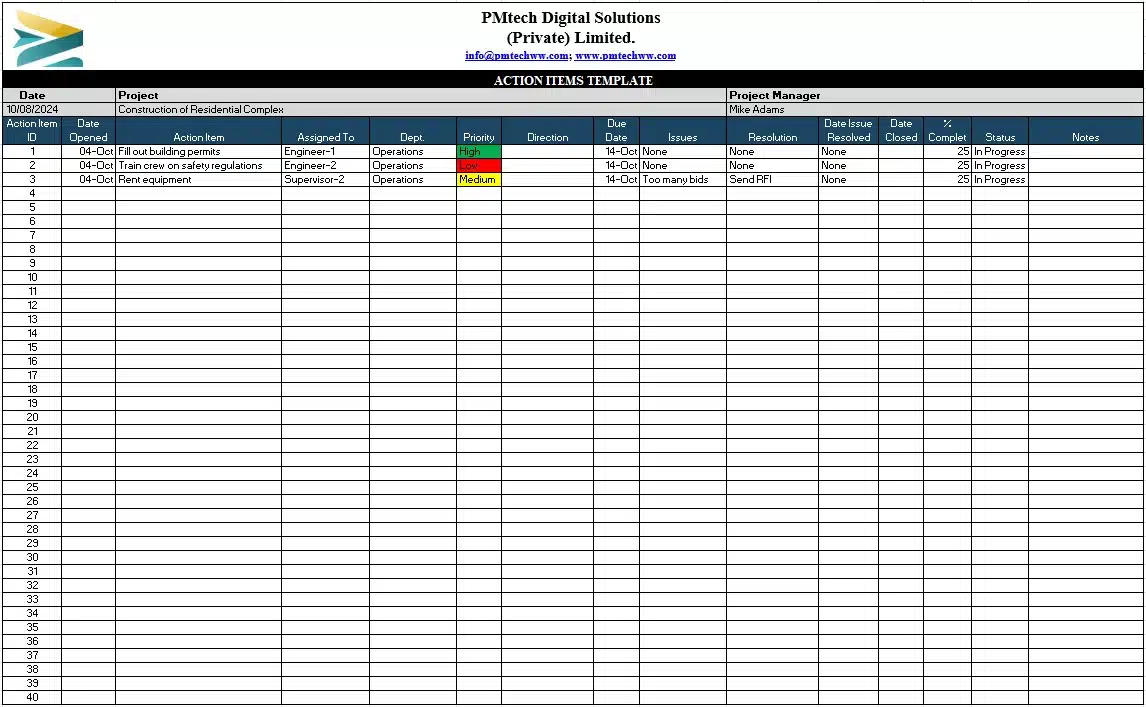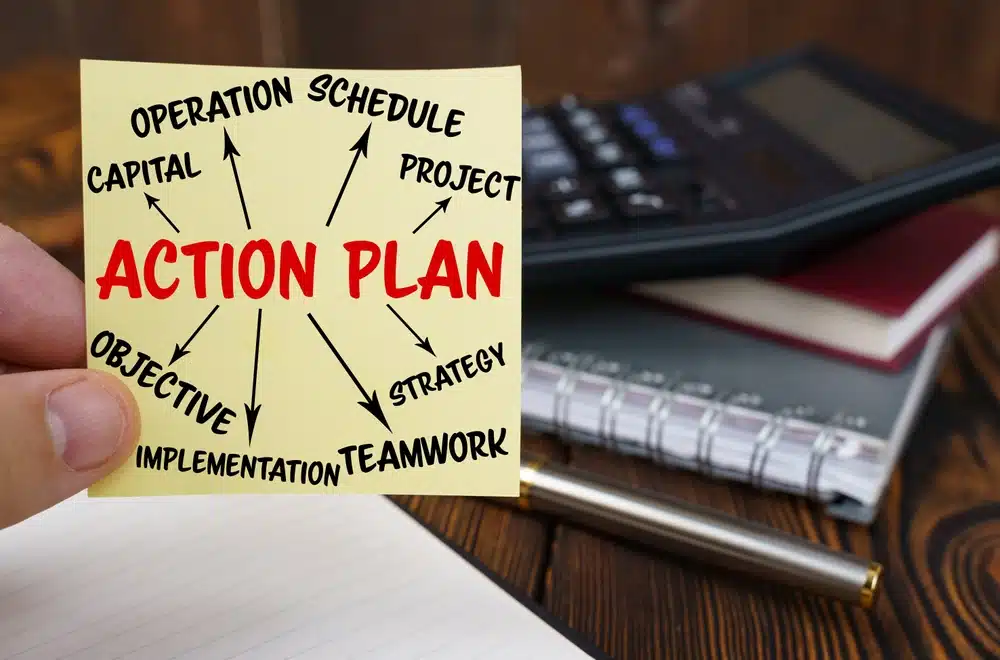Is your team struggling to complete tasks on time? Are you constantly chasing updates and wondering who’s responsible? An effective action item template can boost productivity and streamline workflow.
An action item template is a game-changer for task management. It creates a clear roadmap by documenting tasks, assigning owners, and setting deadlines. This improves communication and accountability while enabling progress tracking.
Studies show that action items offer numerous benefits. They provide clarity around responsibilities and improve communication. They also enable progress tracking and facilitate task completion.
Action items enhance meeting productivity and increase organization. By using an action item template, you can unlock these benefits. Your team’s performance will reach new heights.
We’ll explore key elements of an effective action item template. We’ll also discuss best practices for managing action items. These strategies will maximize their impact on productivity and collaboration.
Key Takeaways:
- Action item templates provide a clear roadmap for task management and project planning
- Assigning owners and deadlines improves accountability and progress tracking
- Effective action items enhance communication, productivity, and collaboration
- Implementing an action item template can unlock significant benefits for your team
- Best practices for managing action items include regular reviews, visibility, and celebration of completed tasks
Understanding the Power of Action Items
Action items drive successful team collaboration and productivity in project management. They transform ambitious goals into tangible results. Action items provide a clear roadmap for teams, ensuring alignment and accountability.
Defining Action Items and Their Benefits
An action item is a specific task arising from a meeting or project planning session. It’s assigned to a team member with a defined timeframe. Action items keep projects organized and maintain momentum.
Using action items in your workflow offers many benefits. These include increased accountability, enhanced communication, and improved task tracking. They also provide clarity on priorities and boost productivity.
- Increased accountability and ownership among team members
- Enhanced communication and collaboration across the team
- Improved task tracking and progress monitoring
- Greater clarity on project priorities and deadlines
- Boosted productivity and efficiency in project delivery
How Action Items Drive Project Success
Effective action items have four key components: what, why, when, and who. These elements provide a framework for executing tasks and achieving milestones. They help define the task, its context, timeframe, and owner.
| Component | Description |
|---|---|
| What | A clear and concise description of the task to be completed |
| Why | The context or rationale behind the task, linking it to the overall project goal |
| When | The specific timeframe or deadline for completing the task |
| Who | The individual or team member responsible for executing the task |
Well-structured action items contribute to project success in several ways. They break down large goals into actionable chunks. They also provide a clear record of tasks and responsibilities.
Action items foster team alignment and collaboration. They enable progress tracking and course correction when needed. They also help celebrate milestones and accomplishments along the way.
- Breaking down large goals into actionable chunks
- Providing a clear record of tasks and responsibilities
- Fostering team alignment and collaboration
- Enabling progress tracking and course correction when necessary
- Celebrating milestones and accomplishments along the way
“Action items help teams stay organized, focused, and motivated throughout projects. They deliver successful outcomes and drive business growth.”
Key Elements of an Effective Action Item Template
An effective action item template boosts team productivity and ensures project success. It includes clear task definitions, ownership, realistic deadlines, and priority levels. These elements help teams stay organized and focused on achieving their SMART goals.
Clearly Defining the Task
Use specific, action-oriented verbs to clearly communicate tasks. Avoid lengthy descriptions that can lead to misinterpretation. Focus on providing concise details about what needs to be done.
Consider who is responsible and when the task is due. The S.M.A.R.T. framework helps create clear, achievable action items. It stands for Specific, Measurable, Assignable, Realistic, and Time-Related.
Assigning Ownership and Accountability
Assigning task ownership is crucial for effective action items. It fosters accountability and ensures timely completion. Consider individual strengths, workload, and availability when assigning responsibilities.
“Clarity in assigning responsibilities for action items, especially in collaborative settings, is crucial for successful task completion.”
Use a project management tool to assign tasks and track progress. This approach streamlines communication and keeps everyone informed about task status.
Setting Realistic Deadlines
Consider task complexity, dependencies, and available resources when setting deadlines. Communicate these deadlines clearly to all team members and stakeholders. This ensures everyone is on the same page.
Unfinished tasks can cause stress and impact sleep quality. Set achievable deadlines and provide necessary support to help your team stay motivated.
Prioritizing Action Items
Assign priority levels to tasks based on their impact and urgency. This ensures critical items receive attention while less pressing tasks are addressed later.
Consider project milestones, dependencies, and potential risks when prioritizing. Align priorities with your project timeline to maintain focus on the most impactful tasks.
| Priority Level | Description | Action |
|---|---|---|
| High | Critical tasks that directly impact project success or have tight deadlines | Address immediately and allocate necessary resources |
| Medium | Important tasks that contribute to project goals but have some flexibility in timeline | Schedule and work on after high-priority items are addressed |
| Low | Tasks that are not time-sensitive or have minimal impact on project outcomes | Delegate or address as time permits, focusing on high and medium-priority items first |
Incorporate these key elements into your action item template to drive project success. Regularly review and refine your template based on feedback and lessons learned.
Implementing an Action Item Template in Your Workflow
An action item template can boost team productivity and project tracking. Log all action items during meetings in real-time to avoid missing anything. Review existing items, capture new ones, assign owners, and set due dates at each meeting.
This practice keeps meetings focused on completed work and ongoing tasks. It ensures discussions are purposeful and centered around progress.
Designate an action item “scribe” to capture and document tasks consistently. Treat these items as deliverables that need completion like any other workstream. Use tools like spreadsheets, Trello, Jira, or Asana to manage items in one place.
Customize your template to fit project tracking needs. Add fields like priority level, milestones, and categories. Break down abstract items into smaller sub-tasks for clarity.
This approach reduces misunderstandings and ensures team members understand their tasks clearly.
“Effective use of action items can streamline projects, provide organized timelines, establish clear expectations, and simplify progress tracking.”
Assign ownership to each item as soon as it’s identified. This prevents tasks from being overlooked and ensures clear responsibility. Link action items to project progress trackers for better monitoring.
Project managers can identify potential delays and take necessary actions to stay on track. Prioritize items to help employees understand critical tasks and urgent deadlines.
Regularly review and update the action item list. Keep it relevant and aligned with project goals. Integrate your template with project management tools for enhanced planning and tracking.
Best Practices for Managing Action Items
Effective action item management boosts team productivity. Key practices include regular tracking, team visibility, and using project management software. These strategies keep our tasks on track and drive project success.
Regular Review and Status Updates
Regular reviews of action items are crucial. We should check progress during team meetings to spot potential issues. Monthly status reports keep stakeholders informed and ensure transparency.
Flag stalled or high-priority items for one-on-one discussions. This focused approach helps critical tasks move forward. Set calendar reminders for due dates to maintain momentum.
Keeping Action Items Visible and Accessible
Project management software creates a central spot for all action items. This transparency lets team members stay informed and offer support when needed.
A visible list promotes accountability and task ownership. It also helps communication, as team members can easily see who’s responsible for each item.
Celebrating Completed Action Items
Recognizing completed action items boosts morale. A public shout-out or personal message can acknowledge team members’ efforts. This recognition motivates individuals and fosters a sense of progress.
Celebrating completed tasks reinforces the importance of our collective work. It reminds us that each finished item brings us closer to our project goals.
| Best Practice | Benefits |
|---|---|
| Regular review and status updates | Identifies roadblocks, maintains momentum, and ensures transparency |
| Keeping action items visible and accessible | Promotes team visibility, collaboration, and accountability |
| Celebrating completed action items | Boosts morale, motivation, and a sense of progress |
These practices improve our action item management and project outcomes. Regular tracking provides insight into progress and allows for timely adjustments. It also creates accountability and motivates on-time completion.
Conclusion
Maximizing team productivity is crucial in today’s fast-paced work environment. A robust action item checklist can streamline workflows and drive better results. PMtech Digital Solutions offers customizable templates for various project types and team needs.
To optimize our action item process, we must foster accountability and discipline. Setting clear expectations and assigning ownership keeps teams aligned and motivated. Celebrating completed tasks reinforces the importance of following through on commitments.
Action item templates save time and energy. This allows us to focus more on high-value tasks. Embracing tools that enhance team productivity is essential in the digital workplace.
Incorporating action item checklists helps unlock our teams’ full potential. PMtech Digital Solutions provides the expertise to tackle any project confidently. We have the right framework in place to succeed.
Let’s prioritize action items and allocate necessary resources. This approach will help our teams thrive and propel our organizations forward. Effective action item management sets the stage for long-term success.










